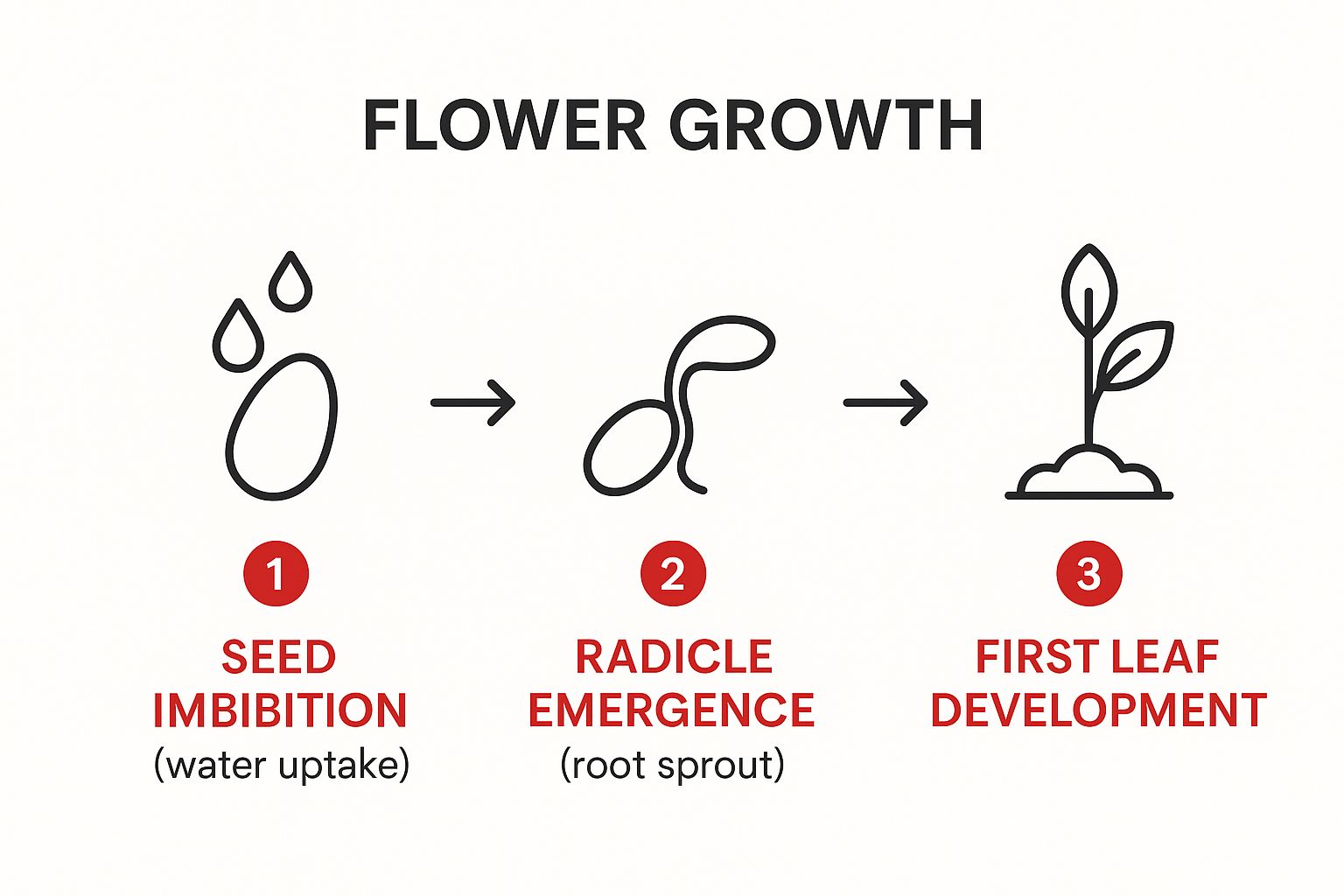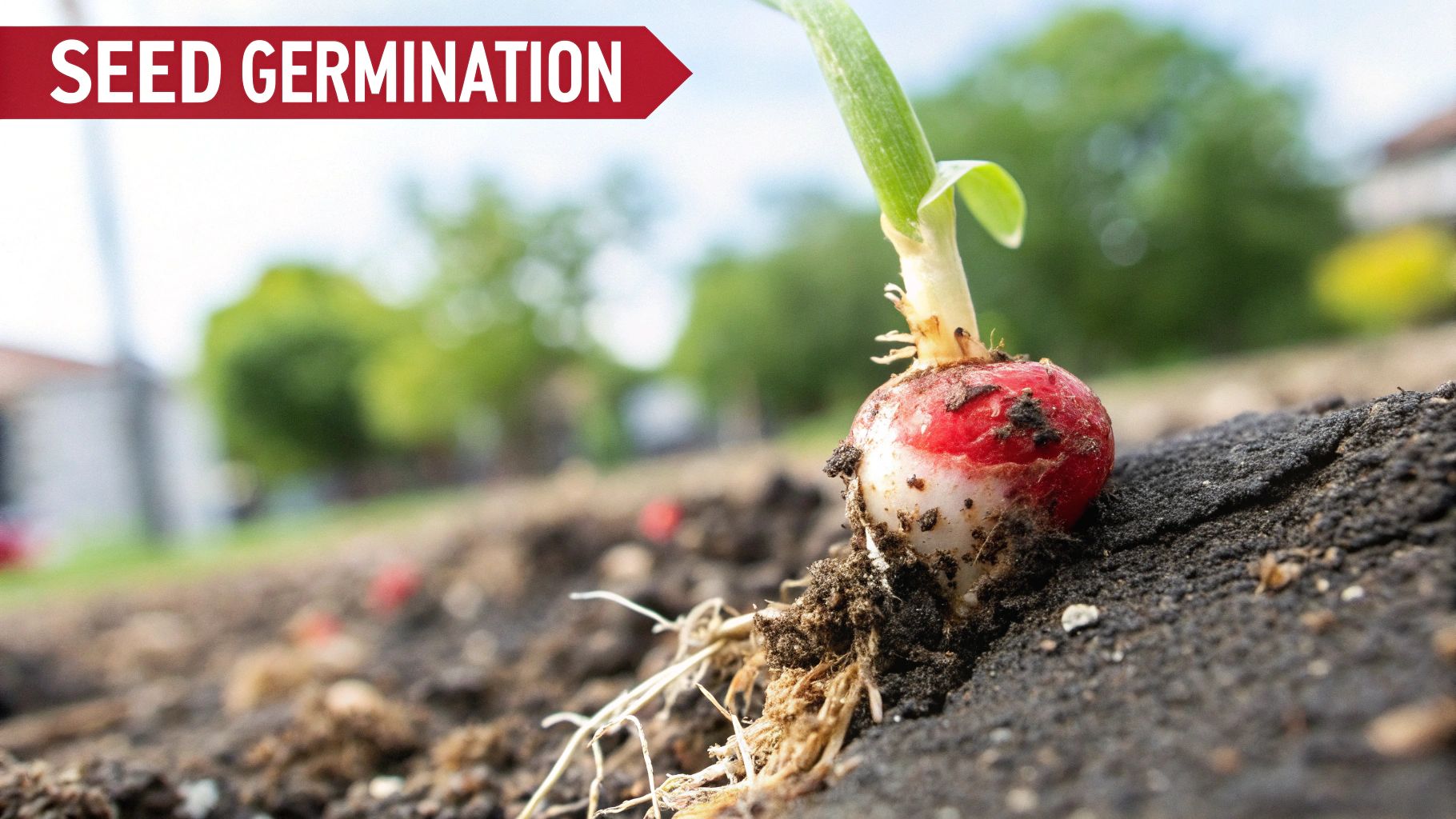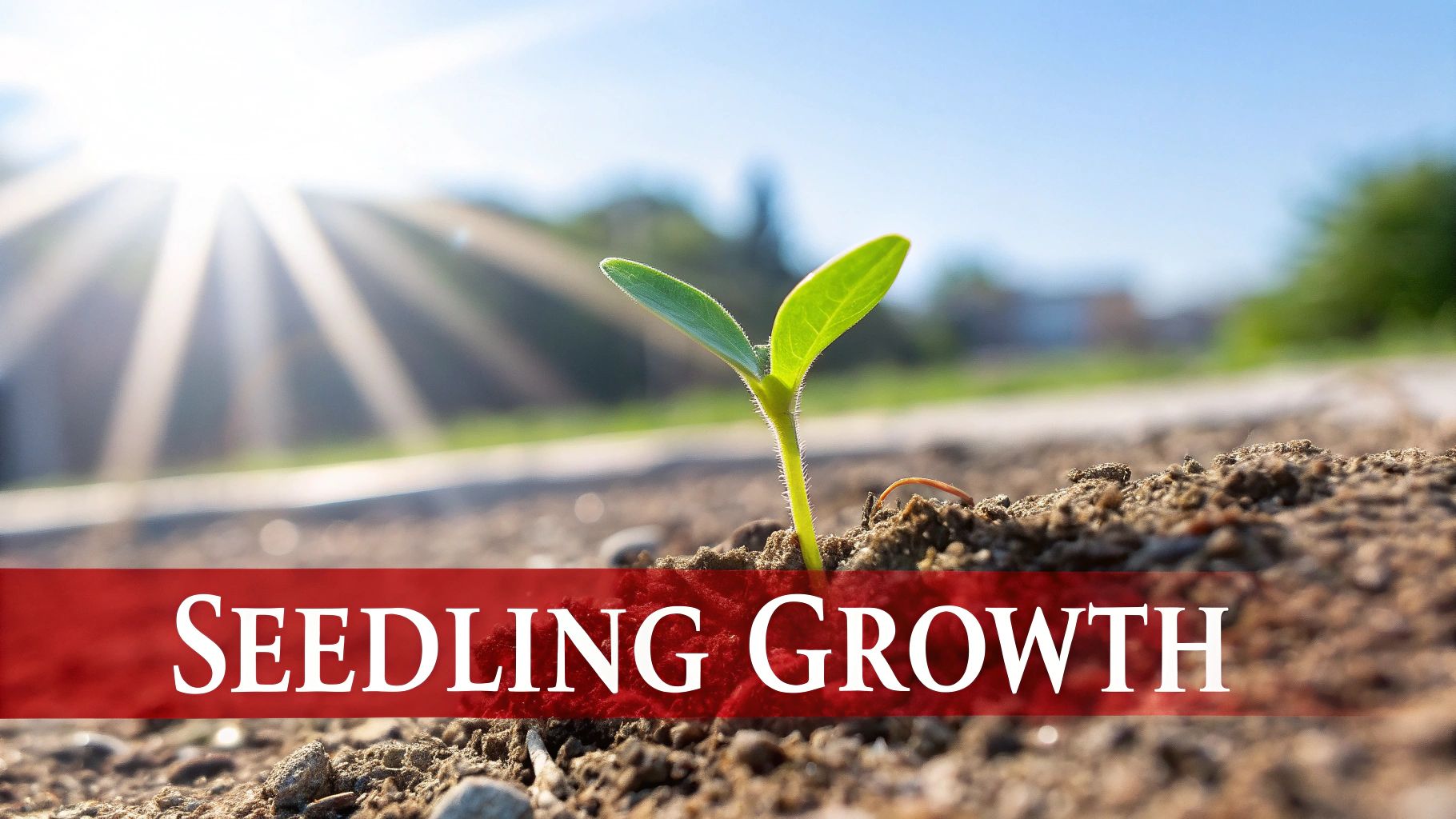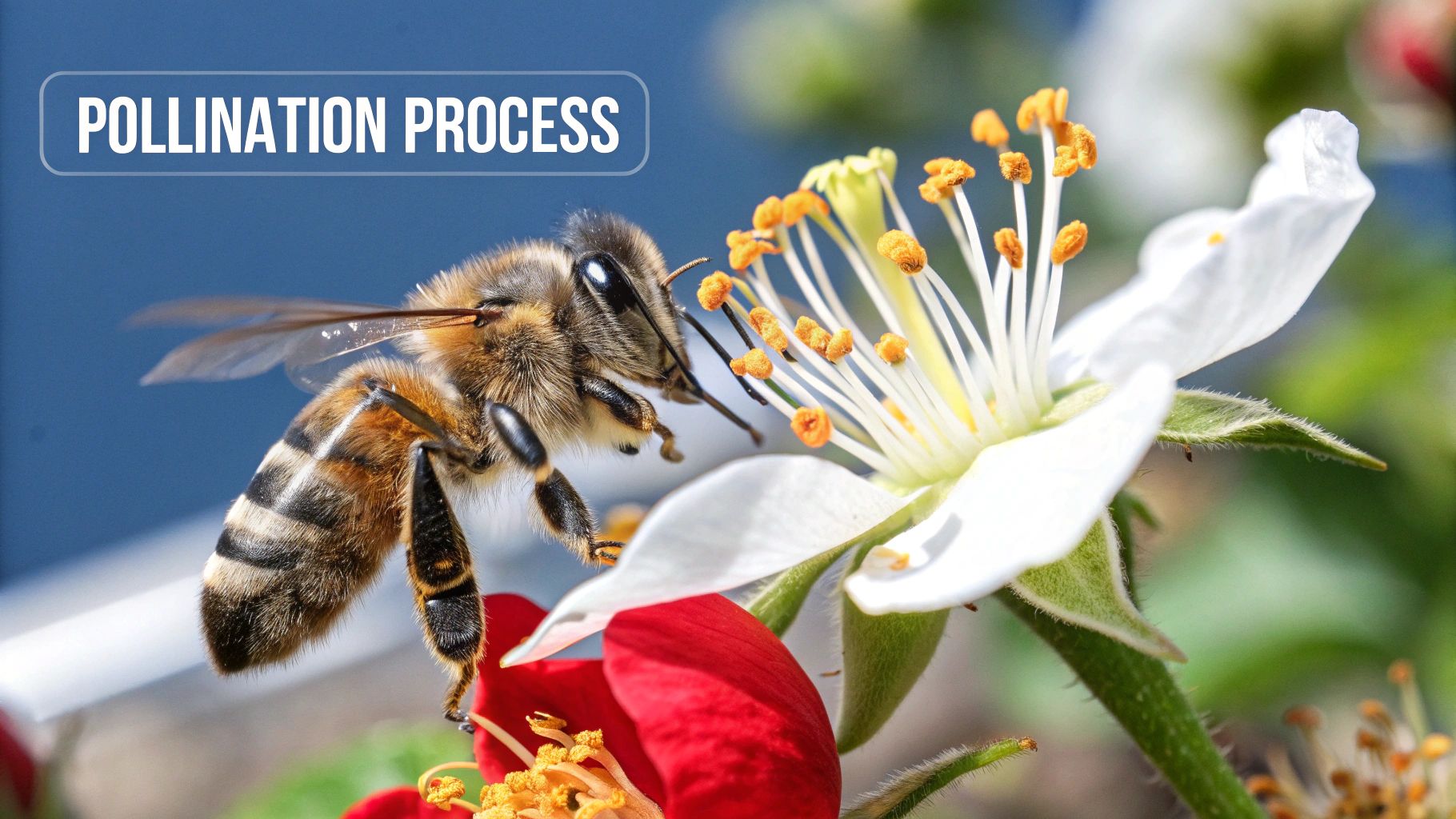
How Do Flowers Grow From Seed to Bloom: A Step-by-Step Guide
Every beautiful flower, from a tiny daisy to a towering sunflower, starts its life as an unassuming seed. It’s a small package of potential, just waiting for the right moment to awaken. This first stage, called germination, is where the magic really begins, turning a dormant seed into a living sprout. It's the incredible opening chapter in the story of a flower.
The Secret Life of a Seed: Waking Up and Sprouting
Think of a seed as a perfectly packed lunchbox for a baby plant. Tucked inside its protective outer shell—the seed coat—is a tiny plant embryo and its own special food supply, the endosperm. This "lunch" has all the energy the little embryo needs to get started, long before it can make its own food.
But this lunchbox won't open just anytime. Seeds are patient. They wait for the perfect combo of warmth, water, and oxygen. When a seed finds itself in some cozy, damp soil, it knows it’s time to wake up. This simple start is part of a massive global industry. The market for flower seeds was valued at around $2.58 billion and is expected to grow to nearly $3.96 billion by 2032. It just goes to show how much people value the very beginning of a flower's life—a process that kicks off when a seed soaks up enough water (over 30% of its weight!) and feels temperatures between 15°C and 30°C.
Unlocking the Embryo with Water and Warmth
Water is the first signal that tells a seed to start its transformation. As water soaks through the seed coat, a process called imbibition, it makes the seed swell up and activates special enzymes inside. These enzymes are like tiny keys, unlocking the stored food in the endosperm and turning it into usable energy for the growing embryo.
Key Takeaway: A seed is a plant's promise of the future. It holds all the instructions and energy needed to burst into life, but it wisely waits for the perfect environmental cues—water and warmth—to ensure its best chance at survival.
Once energized, the embryo starts to grow. The very first part to appear is the radicle, which will become the plant's main root. It pushes downward, anchoring the new seedling firmly into the soil and starting its search for more water and nutrients. Soon after, a small shoot called the plumule pushes upward, reaching for the sunlight that will soon become its new power source.
This is the very beginning of the flower’s journey from a dormant seed to a young sprout.

As you can see, the process flows logically from soaking up water to growing a root, setting a strong foundation before the plant puts any energy into making leaves.
A Fun At-Home Experiment: The Seed Viewer
Watching germination happen with your own eyes is a fantastic way to understand how flowers grow. You can create a simple "seed viewer" with just a few household items. This is one of many great 5th-grade science experiments that really brings botany to life.
- What You Need: A clear glass jar, paper towels, and a few bean seeds (they germinate quickly!).
- What to Do: Dampen the paper towels and line the inside of the jar with them.
- Watch It Grow: Gently place the bean seeds between the glass and the paper towels. Keep the towels moist, and in just a few days, you'll see the radicle poke out, followed by the first tiny leaves.
How Roots Anchor and Drink: The Unseen Foundation
Once a seed cracks open, its first big job happens completely out of sight. Long before you spot a single green leaf, an incredible underground network is already hard at work. This is the root system, and it's the secret to understanding how a tiny seedling grows into a strong, healthy flower.

The very first root to pop out of the seed is called the radicle. It has two critical missions right from the start. First, it dives deep into the soil, acting like an anchor to hold the new plant steady. This keeps the little sprout from being washed away by rain or knocked over by a gust of wind.
At the same time, the radicle and all the smaller roots that branch off from it act like the plant’s personal drinking straws. They soak up water and essential nutrients from the soil—the building blocks every flower needs to survive and grow.
Two Main Types of Root Systems
Not all roots look the same. As a flower matures, it develops one of two main root systems, each with its own strategy for finding food and water.
- Taproots: Think of a carrot or a dandelion. They both have a single, thick main root that grows straight down. That’s a taproot. It's fantastic at reaching water deep in the ground and giving the plant a super-secure anchor.
- Fibrous Roots: Now, picture the messy tangle of thin, branching roots you’d find under a patch of grass or a marigold. That’s a fibrous root system. It spreads out close to the surface, making it great at quickly soaking up rainwater and holding the soil together to prevent it from washing away.
Key Takeaway: The root system is the plant's lifeline. It’s not just a passive anchor; it’s an active, sprawling network that functions as a mouth, a pantry, and a support structure all in one.
Understanding these two types is a big part of learning how flowers grow. A flower with a deep taproot, like a lupine, will likely handle a drought better than one with shallow, fibrous roots.
More Than Just Drinking Straws: Roots as a Pantry
While drinking up water and nutrients is their main job, roots have another cool trick up their sleeve. They double as a storage pantry for the plant. The leaves make sugary food through photosynthesis, and any extra energy gets sent down to the roots to be stored as starch.
This stored food is incredibly important. It helps the plant survive overnight when there’s no sunlight, and it provides the energy boost needed to regrow in the spring after a cold winter. For perennial flowers like peonies, this underground pantry is the key to coming back year after year.
You can actually see this hidden world for yourself! A great way to make this concept stick is with simple hands-on science activities. Carefully dig up a common weed from your yard and gently wash the soil off its roots. Can you see its structure up close? Does it have a long taproot or a web-like fibrous system? This simple observation makes the whole idea click.
Reaching for the Sun with Stems and Leaves
Once a strong root system is locked in place underground, the real show begins above the soil. This is where the plant starts its exciting journey upward, stretching toward the sun—its ultimate power source. The stem and leaves are the stars of this stage, working together to move resources around and, most importantly, create food.

You can think of the stem as the plant's personal superhighway. It’s built with a surprisingly complex plumbing system made of tiny tubes. One set of tubes, the xylem, is like an express lane bringing water and nutrients up from the roots to the rest of the plant.
Another set, the phloem, handles the return trip. It carries the sugary food made in the leaves back down to power the stem and roots. This constant, two-way traffic is absolutely essential for a flower's survival, keeping every part nourished and energized.
The Plant's Solar-Powered Food Factory
At the end of this superhighway, you'll find the leaves—the plant's brilliant, green food factories. Leaves are masterfully designed to capture sunlight, and their main job is to carry out one of the most incredible processes on Earth: photosynthesis. This is how a flower literally makes its own food from thin air and sunlight.
Photosynthesis is like a magical recipe. The plant gathers a few simple ingredients from its surroundings—water from the soil, carbon dioxide from the air, and energy from the sun—and cooks up its own sugary meal. This all happens inside tiny structures in the leaves called chloroplasts, which are packed with a green pigment called chlorophyll. That chlorophyll is what soaks up the sunlight and gives leaves their signature color.
What's really amazing is that this process doesn't just feed the plant; it also creates something we can't live without: oxygen. The oxygen that plants release is the very air we breathe, a beautiful reminder of how connected we are to the plant world.
Key Takeaway: Photosynthesis is nature’s most elegant manufacturing process. Using only light, water, and air, a single leaf becomes a factory that produces the energy for its own growth while simultaneously creating the oxygen that sustains life across the planet.
To make this big idea easier for kids to wrap their heads around, it helps to break it down into a simple recipe. This approach is a fantastic example of using hands-on learning activities to make science click.
A Plant's Recipe for Making Food (Photosynthesis)
This table breaks down the simple 'ingredients' a plant needs for photosynthesis and what it 'makes' as a result, helping to clarify this essential process.
| What the Plant Takes In (Ingredients) | Where It Comes From | What the Plant Makes (Products) | What Happens to It |
|---|---|---|---|
| Water (H₂O) | Absorbed from the soil through the roots | Glucose (Sugar) | Used immediately as energy or stored in roots for later use |
| Carbon Dioxide (CO₂) | Taken from the air through tiny leaf pores | Oxygen (O₂) | Released back into the air as a byproduct we breathe |
| Sunlight | Captured by chlorophyll in the leaves |
As you can see, it’s a pretty simple list of ingredients for such a powerful result. This "recipe" is running constantly in billions of leaves all over the world, powering not just one flower, but entire ecosystems.
The glucose, or sugar, is the high-energy fuel that powers everything the flower does—from strengthening its stem and growing more leaves to eventually forming the buds that will become beautiful blooms. Any extra sugar is sent down the phloem highway and stored in the roots, saved up for a rainy day or a long winter.
From a Tiny Bud to a Beautiful Bloom: The Flowering Stage
After all the hard work of growing roots, a stem, and plenty of leaves, the plant is finally ready for the main event—the bloom. This stage kicks off with a small, tightly wrapped flower bud. Think of it like a beautifully wrapped present, keeping the delicate petals safe from wind, rain, and nosy insects until the perfect moment arrives.
Inside that protective little package, a huge transformation is underway. The plant is pouring all the energy it made through photosynthesis into forming the flower's intricate parts. When the conditions are just right—triggered by things like the length of the days and the temperature—the bud starts to unfurl, revealing the incredible colors and shapes we all love.
The Anatomy of a Flower: A Closer Look
Once a flower opens up, you can see all its different parts working together. Each one has a specific job in the big story of how flowers grow. Getting to know these parts helps pull back the curtain on the clever design behind every single bloom.
- Sepals: These are the little leaf-like bits at the base of the flower. Before the bud opens, the sepals are its protective armor, wrapping tightly around the developing petals.
- Petals: These are the show-stoppers. Their bright colors, eye-catching patterns, and sweet smells aren't just there for us to enjoy—they're basically advertisements designed to attract pollinators like bees and butterflies.
- Stamen: This is the male part of the flower, and its job is to produce pollen. It’s made of a long stalk called a filament with a pollen-covered anther on top.
- Pistil: Tucked in the center, this is the flower's female part. Its role is to catch pollen and help it develop into a seed.
Seeing these parts in action is a fantastic way to learn. You can get a hands-on look at this process by growing your own flowers in a controlled environment with something like a Mars Greenhouse Cloning Kids Science Kit.
Why Are Flowers So Colorful and Fragrant?
The amazing colors and sweet smells of flowers are all about survival. They're a direct line of communication with the outside world, especially with the pollinators they need to reproduce. A brilliant red poppy practically yells "come visit me!" to a passing bee, while the sweet scent of a lilac invites a butterfly to stop for a drink of nectar.
Key Takeaway: A flower’s beauty is not just a happy accident of nature; it is a highly evolved survival strategy. Every color, pattern, and fragrance is a carefully crafted invitation to the pollinators that will help the plant create the next generation.
This process is so vital that it supports a massive industry. The global flower cultivation market was valued at around USD 57.15 billion and is expected to climb to over USD 75.21 billion by 2031. Growers often use controlled setups like greenhouses, which can increase flower yield by 20% to 40% by perfectly managing the conditions that lead to healthy buds and vibrant blooms.
Ultimately, the flowering stage is the grand finale of a plant's journey. It's the culmination of all the energy gathered by the roots, stem, and leaves. Every beautiful bloom is a testament to this incredible natural process, designed not just to look pretty, but to ensure the plant's legacy continues.
How Flowers Work with Pollinators to Create New Seeds
Once a flower unfurls its petals, its most important job begins. This is the moment for pollination—the incredible process that lets flowers create seeds for the next generation. It’s a beautiful story of teamwork, where plants and animals work together in a partnership that’s millions of years old.
So, how does this amazing collaboration work? Let’s follow a busy little bee.

She isn't thinking about making seeds; she's just on the hunt for a sugary drink of nectar to bring back to her hive. As she lands on a bright sunflower and sips, she gets dusted with tiny yellow grains of pollen from the flower’s stamens.
When she flits over to the next sunflower, some of that pollen brushes off onto its pistil. That simple transfer is the key. The pollen then travels down the pistil, kicking off the process of making a brand-new seed. Just like that, the plant’s life cycle is ready to start all over again.
The Amazing Pollinator Squad
Bees are absolute superstars, but they’re just one member of a much larger pollinator team. Flowers have evolved all sorts of clever tricks to attract different kinds of helpers, each perfectly suited for a specific type of bloom.
- Butterflies: These graceful insects love brightly colored flowers, especially pinks, purples, and yellows. They prefer blooms that are flat-topped, like zinnias, which give them a perfect landing pad to rest on while they drink.
- Hummingbirds: With their long beaks and an insatiable sweet tooth, hummingbirds are designed for deep, tube-shaped flowers like petunias and lupines. They’re especially drawn to the color red—a vibrant signal that a sugary meal is waiting inside.
- The Wind: Some plants, like grasses and many trees, don’t bother with fancy colors or sweet smells. They just release massive amounts of lightweight pollen into the air and let the wind do all the work, carrying it to the next flower.
This critical stage depends on the right environmental conditions for both the flowers and their pollinators. For example, the floriculture industry in countries like Kenya thrives because the equatorial climate allows for year-round flower production. Stable temperatures between 18°C and 25°C keep the blooms healthy, ensuring that pollinators always have a reason to visit and complete the growth cycle.
Key Takeaway: Pollination is nature's beautiful bargain. The flower offers a reward of sweet nectar, and in exchange, the pollinator provides the essential service of carrying pollen from one bloom to another, ensuring the survival of the species.
Meet the Pollinators and Their Favorite Flowers
To see this teamwork in action, it helps to see what different pollinators look for in a flower. You’ll notice how specific these relationships can be, which makes for a fascinating topic to explore in an example of a science fair project.
| Pollinator | What Attracts Them | Example of Flowers They Visit |
|---|---|---|
| Bees | Brightly colored (especially blue and yellow) and sweet-smelling flowers. | Sunflowers, Lavender, Cosmos, Poppies |
| Butterflies | Brightly colored, flat-topped flowers that provide a landing spot. | Zinnias, Coneflowers (Echinacea), Milkweed |
| Hummingbirds | Red, long, and tubular-shaped flowers with lots of nectar. | Petunias, Lupines, Columbines, Fuchsias |
| Moths | Pale or white flowers that are open at night and have a strong, sweet scent. | Evening Primrose, Jasmine, Honeysuckle |
| Wind | N/A (no attractants needed) | Oak Trees, Grasses, Ragweed |
As you can see, every flower has a strategy. This incredible partnership between plants and pollinators is responsible for producing not only more flowers but also a huge portion of the food we eat, from apples and almonds to cucumbers and coffee. Protecting these amazing creatures is essential for a healthy planet and for the beautiful cycle of how flowers grow to continue.
Got Questions? We’ve Got Answers.
After walking through the incredible journey from a tiny seed to a full-blown flower, it's only natural for curious minds to have a few more questions buzzing around. The world of plants is packed with clever tricks and fascinating details.
Let's dig into some of the most common questions to round out our understanding of how flowers really work.
How Long Does It Take for a Flower to Grow From a Seed?
This is one of the first questions everyone asks, and the honest answer is: it completely depends on the flower! There's a huge range in how long a plant needs to complete its journey.
Some annuals, like marigolds or cosmos, are the sprinters of the plant world. If the conditions are just right, they can go from a seed in the ground to a beautiful bloom in as little as 8 to 12 weeks. Their speedy growth is why they're such a popular choice for filling up summer gardens with quick color.
On the flip side, some plants are in it for the long haul. Perennials like lavender or peonies might take a full year—or sometimes even longer—to build up a strong, healthy root system before they feel ready to produce their first flowers. And, of course, the environment is a massive factor; any plant will grow faster and stronger with the perfect mix of sun, water, and good soil.
Why Do Some Flowers Only Bloom at Certain Times of the Year?
Ever wonder why tulips are a sure sign of spring, zinnias love the summer sun, and mums show up just in time for fall? That's not a coincidence! Flowers are incredibly tuned in to the amount of daylight they get each day, a response known as photoperiodism.
It’s the plant's internal clock, telling it what season it is and when the time is right to bloom.
- Short-Day Plants: Flowers like chrysanthemums and poinsettias need long, uninterrupted nights to get the signal to start budding. As the days get shorter in the fall, they know it's their time to shine.
- Long-Day Plants: Poppies and coneflowers are the opposite. They need long stretches of daylight to start flowering, which is why you see them putting on their best show during the peak of summer.
- Day-Neutral Plants: Then you have the easy-going flowers like roses and zinnias. They don't really pay attention to day length. As long as the temperature is right and they’re mature enough, they'll just keep on blooming.
Key Takeaway: A flower's schedule isn't random—it's a brilliant survival strategy timed perfectly with the sun. By sensing the changing length of days, plants make sure they bloom when their favorite pollinators are most active and when conditions are perfect for making healthy seeds.
Can Flowers Grow Without Any Soil?
Yes, they absolutely can! We usually picture flowers growing happily in a garden bed, but a super cool method called hydroponics lets plants thrive in nutrient-rich water instead of soil. It might sound like something out of a sci-fi movie, but it's a real and effective way to grow all sorts of plants.
In a hydroponic setup, a plant's roots are suspended in water that’s been mixed with all the essential minerals and nutrients it needs to grow. This gives the grower total control over the plant’s diet. Hydroponics is used all the time in commercial greenhouses to grow everything from lettuce to tomatoes to flowers, allowing for year-round harvests no matter what the weather is like outside.
What Is the Difference Between an Annual and a Perennial Flower?
The biggest difference between these two types of flowers boils down to their lifespan. Knowing which is which helps any gardener plan for what to expect year after year.
- Annuals: An annual flower lives its entire life—from seed, to flower, to making new seeds—all in one growing season. Think of classic garden favorites like zinnias, petunias, and marigolds. Once they've produced their seeds, the original plant dies off.
- Perennials: A perennial flower is one that lives for more than two years. Plants like daisies, lavender, and peonies might look like they've disappeared in the winter, but their root systems are just dormant underground, waiting for spring. When warm weather returns, they use their stored energy to grow back, often bigger and stronger than the year before.
Choosing between them is all about your gardening style. Annuals are fantastic for a big burst of color that you can change up every year, while perennials provide a reliable, beautiful foundation that comes back all on its own.
At Playz, we believe hands-on learning is the best way to make big ideas feel simple and fun. Exploring how flowers grow is a perfect way to connect with the natural world and see science happen right before your eyes. To keep the discovery going, check out our amazing collection of science kits and educational toys that bring learning to life.
Find the perfect kit to spark curiosity at Playz.
